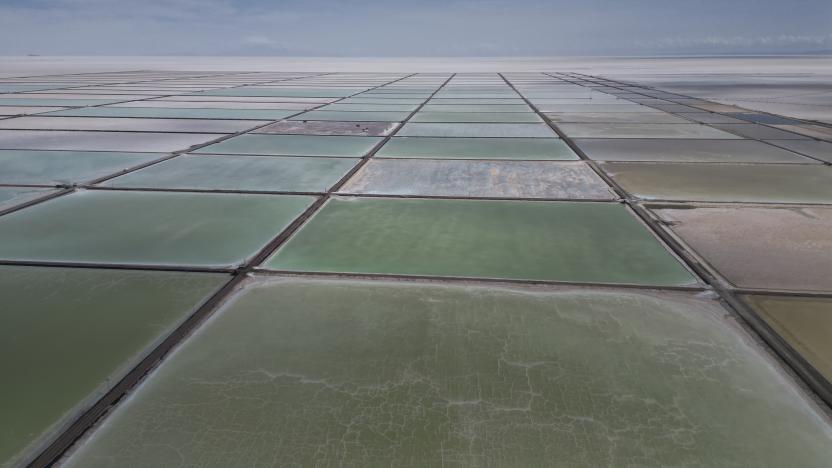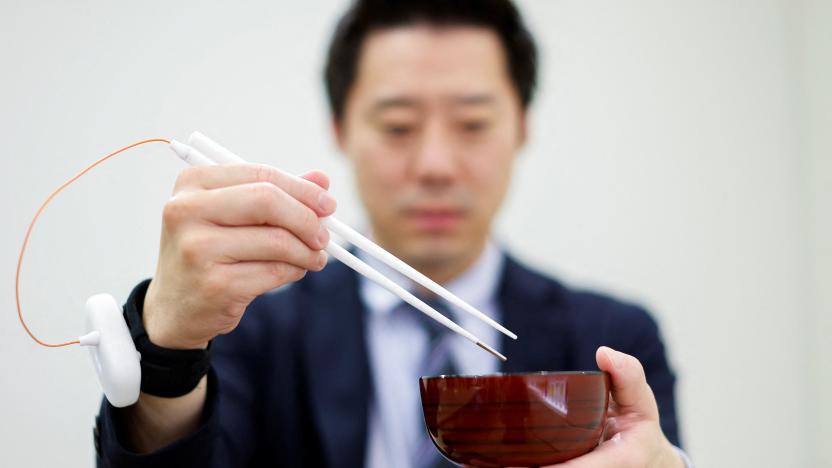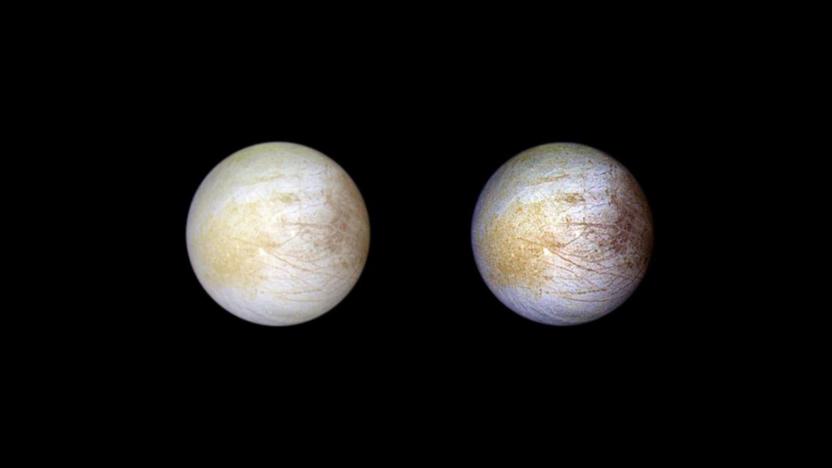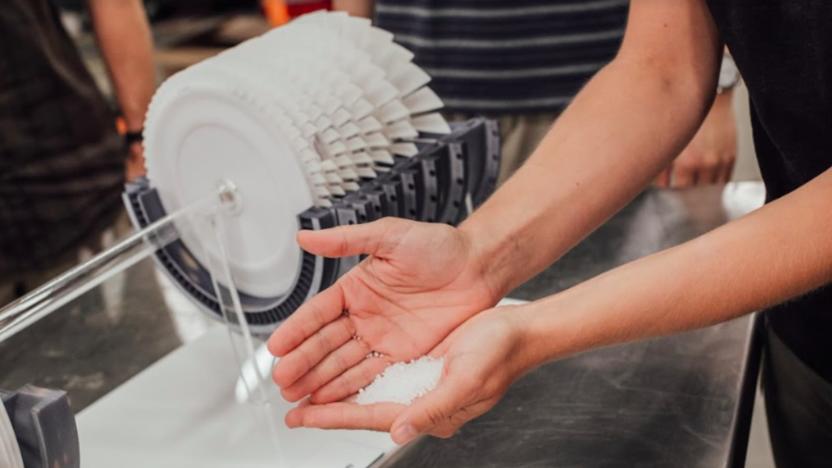salt
Latest

How we built a less-explodey lithium battery and kickstarted the EV revolution
For the final installment of Hitting the Books for 2023, we're bringing you an excerpt from the fantastic Material World: The Six Raw Materials That Shape Modern Civilization by Ed Conway.

The lickable-TV guy created electric chopsticks to make food taste saltier
It could help people reduce their sodium intake.

There's table salt on one of Jupiter's moons
The ocean that scientists believe exists underneath Europa's thick icy crust might be more like our own than previously thought. According to a new study published in Science Advances, a team of researchers used the Hubble Space Telescope Imaging Spectrograph (STIS) instrument to scan Jupiter's moon in infrared light. The team found what's called the "spectral signature" of irradiated sodium chloride, also known as table salt.

Alphabet's hot salt energy-storage project becomes its own company
Alphabet's X division has played host to a string of experimental ideas, and another one is spinning out as an independent business. Malta uses cheap, abundant materials including salt, anti-freeze and steel to store power at grid scale.

Alphabet is using salt and antifreeze to store power from wind farms
The latest from Alphabet's experimental X division? A storage solution for renewable energy. Code named "Malta," the system uses tanks of salt and antifreeze (or another hydrocarbon liquid) to create and store energy.

Dining with the electric fork that could save lives
This prototype fork can help you eat less salt and could save lives. It sends a gentle electric current to your tongue as you eat, fooling tastebuds into experiencing a salty, (sometimes sour) taste -- even when there's little to no salt in the food itself. Despite the awkward notion of willingly putting an electric current into your mouth, the "electro-fork" can potentially tackle some legitimate health issues. According to the World Health Organization, we consume 10 grams of salt a day -- double the amount it recommends. This increases one's chances of hypertension, heart disease, strokes and more. So, in the interest of my health (and morbid curiosity), I went for a taste test.

'Salt' is a gun and pepper spray in one (update)
Salt's Indiegogo campaign says it "was designed around the belief that a gun does not have to take a life to protect a life." See, it might look like conventional handgun, but its bullets aren't made of lead. Instead, they're pellets that contain a proprietary mixture of powdered chemicals, including oleoresin capsicum: a ghost pepper extract used for pepper sprays. Since the pellets explode when they collide with a solid object, you don't even have to hit your target. Its creators said the powder mixture, which "exceeds the potency of those used by" Homeland Security and the military, causes temporary blindness, makes the lungs constrict and stings the human skin. Update (11/11/15): Salt is now available for pre-order from its official website. The company plans to ship the first 250 pieces out in 2016 and is currently selling the device at $50 less its official retail price ($350).

Jupiter's moon Europa might be coated in irradiated sea salt
Astronomers have spent more than a decade trying to identify the dark substance erupting from geological features on the surface of Europa. Now, a team of researchers at NASA's Jet Propulsion Lab believe they've identified the mystery material as sea salt. You know, from the ocean that NASA suspects is hiding under Europa's icy surface. The team, led by planetary scientist Kevin Hand, began its investigation by building a testing device that recreates the extreme conditions found on the gas giant's moon. "We call it our 'Europa in a can,'" Hand said in a statement. "The spectra of these materials can then be compared to those collected by spacecraft and telescopes."

Scientists find a way to make fracking less horrible for the environment
Using fracking (hydraulic fracturing) to get oil or gas may fulfill energy needs, but it has a nasty impact on the environment. Among other things, it leaves behind extremely salty water. However, scientists at both MIT and the King Fahd University of Petroleum and Minerals have found technology that could soften the blow. Their approach filters output water through multiple stages of electrodialysis, which uses electrical charges to pull salt through a membrane. This wouldn't make the water drinkable, but it would be reusable -- and that, in turn, would reduce or even eliminate the need for fresh water beyond an initial supply. Oil and gas wells wouldn't deprive local communities of nearly as much drinking or farming water, and they wouldn't have to dispose of quite so many contaminated liquids.

Green House's lantern runs on salt and water, powers your gadgets via USB
Japanese company Green House Co Ltd has quite an eclectic product portfolio, what with its women-only camcorder and peripherals like a PCI Express interface card with USB 3.0 support. Its latest device falls under another category entirely: the rivetingly named GH-LED10WBW is an LED lantern that runs on just water and salt; no batteries required. The light source provides eight hours of electricity per dose of saline water, and the lantern comes with a dedicated water bag for mixing the solution. The salt / water combo acts as an electrolyte with the magnesium (negative electrode) and carbon (positive electrode) rods inside the lantern. Users can get about 120 hours of power with the Mg rod before they'll need to buy a replacement (the rod is sold separately to begin with). More than just supplying a battery-free source of light, though, the lantern can function as a charger, thanks to a USB port built into the casing. Pricing has yet to be announced, but the GH-LED10WBW will be available by mid-September.

Salt enables six times the storage capacity for snail-unfriendly hard drives
Salt: sure, you might use it to cure meats for your latest solar-powered circumnavigation. But hold onto your kippers, Magellan, because Singaporean scientists have found that sodium chloride -- ordinary table salt! -- can also dramatically increase storage capacity. You see, typical hard drives have randomly-arranged magnetic grains, which allow data density of about 0.5 terabit per square inch. But a high-resolution e-beam lithography process, aided by our good friend NaCl, arranges the grains in a tighter, more orderly fashion, upping the density to 3.3 terabits per square inch. Called nanopatterning, this technique enables a 1TB drive to hold 6TB without additional platters; it also works with current manufacturing technology, meaning no expensive upgrades. If that's got you dreaming of a higher-capacity future, hit the source link for more glorious technical details. We'll warn you, though: the pictures of luscious, bee-stung lips stop here.

Microbial fuel cell produces hydrogen from wastewater without wasting energy
Back in 2005, Bruce Logan and his team of Penn State researchers developed a microbial fuel cell capable of converting poop into power. Now, Logan has refined his system to the point where it can produce hydrogen from wastewater or biodegradable organic materials without using a drop of grid electricity, and without emitting even a hint of carbon dioxide. His approach, outlined in the September 19th issue of the Proceedings of the National Academy of Sciences, involves something known as reverse-electrodialysis (RED) -- a process that harvests energy from the ionic discrepancy between fresh and salt water. Logan's bacterial hydrolysis cell (pictured left) features a so-called RED stack that's comprised of alternating positive and negative ion exchange membranes, which it uses to split water molecules into hydrogen and oxygen. Normally, this process would involve about 25 pairs of membranes, but by using RED technology in conjunction with electricity-producing exoelectrogenic bacteria, Penn State's team was able to extract hydrogen with just five membrane pairs. All told, Logan's cells proved to be about 58 to 64 percent energy efficient, while producing between 0.8 to 1.6 cubic meters of hydrogen for every cubic meter of liquid that passed through the system. The researchers' results show that only one percent of that energy was used to pump water through the cells, which are completely carbon neutral, as well. According to Logan, this breakthrough demonstrates that "pure hydrogen gas can efficiently be produced from virtually limitless supplies of seawater and river water and biodegradable organic matter." Somewhere, the US Navy is taking scrupulous notes. Full PR after the break. [Image courtesy of Penn State / Bruce Logan]

Sony launches a Salt on the App Store
Remember Salt? No, not the tasty mineral humans require in moderate amounts, but the Angelina Jolie movie from this summer. Way late for the theatrical release, but just in time for next week's DVD and Blu-ray retail versions, Sony Pictures has released an iPhone and iPad game based on the film. The good news is that the side-scrolling action game is free. The bad news is the game. See for yourself after the break.

Inhabitat's Week in Green: robot cars, solar winds and the DeLorean EV
Each week our friends at Inhabitat recap the week's most interesting green developments and clean tech news for us -- it's the Week in Green. In case you missed it yesterday, the big green tech news of the week rolled in last night with the announcement of Google's top-secret robot car project, which has been deploying and testing self-driving robot cars on the streets of California over the past several months! (Engadget covered it here). It's also been a big week in general for green transportation announcements, as several supercharged electric vehicles hit the streets last week: the Delorean EV took us back to the future and SiGNa Chemistry unveiled an electric bike that runs on water. Finally, from the realm of tomorrow we brought you the future of moving house: strapping your home to an enormous balloon and lifting off for the skies. This week solar power also lit up the newswires as President Obama announced plans to deck out the White House with photovoltaics this coming spring and scientists proclaimed that interstellar solar winds could provide 100 billion times the Earth's energy needs. We were also wowed by a dog park powered by poo in Cambridge, and we can't wait to get our hands on this new copper-covered Nokia phone that recharges its battery using body heat. Speaking of eco gadgetry, we also showcased a set of gorgeous wooden wristwatches, and the world's first iPhone 4 cover made of plants. Green lighting was also a hot topic this week as scientists created a new type of glowing nano LED and we spotted an array of luminous lamps made from salt at the London Design Festival. We also learned how a wireless router scored a date for one lucky Inhabitat writer, and how Inhabitat editor Jill's solar-powered backpack has been a real conversation starter. See, green gadgets can help you make friends and influence people!

PC Keyboard Salt and Pepper Shakers don't support SureType
Just what you needed, right? After a hard day's night pounding away on keys for The Man, do you really want to season your grub with a little QWERTY? Amazingly, we bet the answer is still yes. Get your set now for $10.95.[Via technabob]

Wave-powered Edinburgh Duck desalinates seawater
Sure, in theory we could use the LifeStraw to purify enough water to quench the thirst of thousands of people, and if Aqua Sciences proves successful in its endeavor to pull water out of thin air, desalinating the seas could prove unnecessary. Nevertheless, Stephen Salter at Edinburgh University in the UK is working with a research team to perfect the "Edinburgh Duck" and provide useful water for needy individuals. The desalinating critters convert wave energy into pressure changes that aid the collection of pure water (in the form of steam) from seawater; by lowering air pressure, the system can draw steam from water at lower temperatures. The pressure-driven machines operates sans electricity by using the crashing motion of waves to operate its innards in a "piston-like motion," slowly but surely creating salt-free water that's pumped back ashore through the two legs that tether the duck to the seabed. Although current prototypes are only pumping air, finalized units could be 10 meters in diameter and 20 meters long -- a device large enough to supply water for "more than 20,000 people." While we're sure the targeted audience here is arid countries with good access to seawater, those days at the beach would be much more enjoyable without generous helpings of NaCl finding their way into our mouths.[Via Slashdot]










